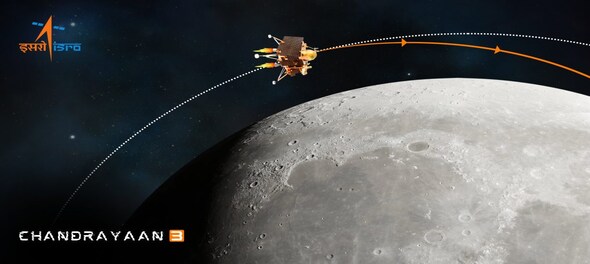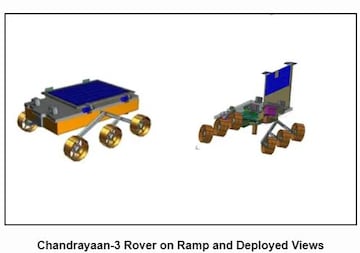
After two round of "deboosting", Chandrayaan-3 is now just a step a away from attempting a soft-landing on the Moon's south pole on Wednesday. The Indian Space Research Organisation (ISRO) said in a tweet on Sunday that India third lunar mission is all set to land on the moon at 6:04 pm on August 23. The Indian space agency also shared details where one can watch the live telecast of the historic event. India will become the world's first country to make a soft landing on the Moon's south pole if Chandrayaan-3's lander module emerges successful in the mission.
But soft-landing is not the only goal of the latest lunar mission. As Chandrayaan-3 gears up for achieving another milestone, here's a look at what it aims to achieve during the entire mission.
Chandrayaan-3 "is expected to be supportive to ISRO’s future interplanetary missions", the Indian space agency said, adding that the deployment of rover and in-situ scientific experiment will scale new heights in lunar expeditions by deploying the rover. Also Read: Why the lunar south pole fascinates scientists
 (Credit: ISRO)
(Credit: ISRO)There are three objectives of the Chandrayaan-3 mission:
1. To demonstrate safe and soft landing on the lunar surface: India has already managed to achieve a hard-landing on the Moon's south pole with its Chandrayaan-1 mission which was launched on October 22, 2008. The Moon Impact Probe (MIP) fixed atop the Chandrayaan-1 orbiter had crash-landed on the lunar surface on November 14, 2008.
2. To demonstrate rover roving on the moon
3. To conduct in-situ scientific experiments: Two modules are parts of Chandrayaan-3 spacecraft: Propulsion Module (the orbiter) and the Lander Module (consisting lander Vikram and rover Pragyan). The lander and the rover have scientific payloads to carry out experiments on the lunar surface. Here, we discuss in detail the role of all three components and what they will study over their mission life:
The mission life of the propulsion module is three to six months. Meanwhile, the mission life of both the lander and the rover is one lunar day or 14 Earth days.
Propulsion module and its role
The propulsion module (orbiter) circling the moon will observe the light coming from the Earth, the only planet teeming with life. This observation wil help in understanding the nature of distant planet circling starts other than the Sun.
SHAPE (Spectro-polarimetry of Habitable Planet Earth): It's an experimental payload to study the spectro-polarimetric signatures of the habitable planet Earth in the near-infrared (NIR) wavelength range (1-1.7 μm).
Lander and its role
The lander will have the capability to soft land at a specified lunar site and deploy the rover that will carry out in-situ chemical analysis of the Moon's surface during the course of its mobility. It has three payloads:
1. RAMBHA-LP (Langmuir Probe): To measure the near surface plasma (ions and electrons) density and its changes with time.
2. ChaSTE (Chandra’s Surface Thermophysical Experiment): To carry out the measurements of thermal properties of lunar
surface near polar region.
3. ILSA (Instrument for Lunar Seismic Activity): To measure seismicity around the landing site and delineating the structure of the lunar crust and mantle.
Rover and it's role
The rover has two payloads:
APXS (Alpha Particle X-Ray Spectrometer): To derive the chemical composition and infer mineralogical composition to further enhance our understanding of lunar surface
LIBS (Laser Induced Breakdown Spectroscope): To determine the elemental composition (Mg, Al, Si, K, Ca,Ti, Fe) of lunar soil and rocks around the lunar landing site.
 (Credit: ISRO)
(Credit: ISRO)The surged interest in Moon's south pole is because of its potential water resources and unique geological features. The relatively unexplored region is pivotal for future lunar missions, including the upcoming Artemis-III mission by the US space agency NASA, which aims to carry humans to the Moon after a five-decade hiatus.
The lunar south pole poses formidable challenges for exploration. Its rugged and treacherous terrain and perpetual darkness in some areas have deterred missions thus far. Temperatures plummet to astonishing lows of -230 degrees Celsius, creating a harsh environment.
Learning from the past experiences, the ISRO has worked around the clock to deal with the complexities of the Moon's south pole which is said to have remained deprived of the sunlight for years. With key improvements this time, the ISRO has been exuding confidence about Chandrayaan-3 successfully making a soft landing on the Moon. Even "if everything fails, if all the sensors fail, nothing works, still it (Vikram) will make a landing. That’s how it has been designed — provided that the propulsion system works well,” Somanath said.
Check out our in-depth Market Coverage, Business News & get real-time Stock Market Updates on CNBC-TV18. Also, Watch our channels CNBC-TV18, CNBC Awaaz and CNBC Bajar Live on-the-go!


Andhra Pradesh: Kuppam loyalty test for TDP chief Chandrababu Naidu
May 6, 2024 9:35 AM
PM Modi visits Ram Mandir for first time since 'Pran Pratishtha', offers prayers before roadshow
May 5, 2024 8:59 PM

